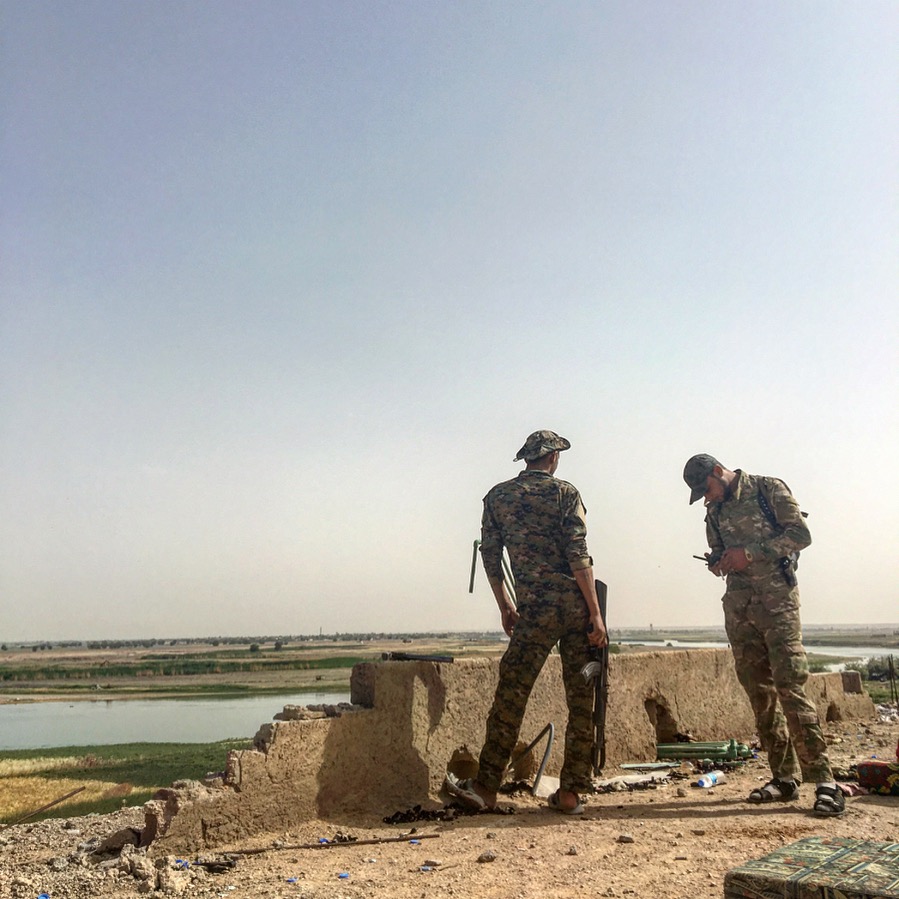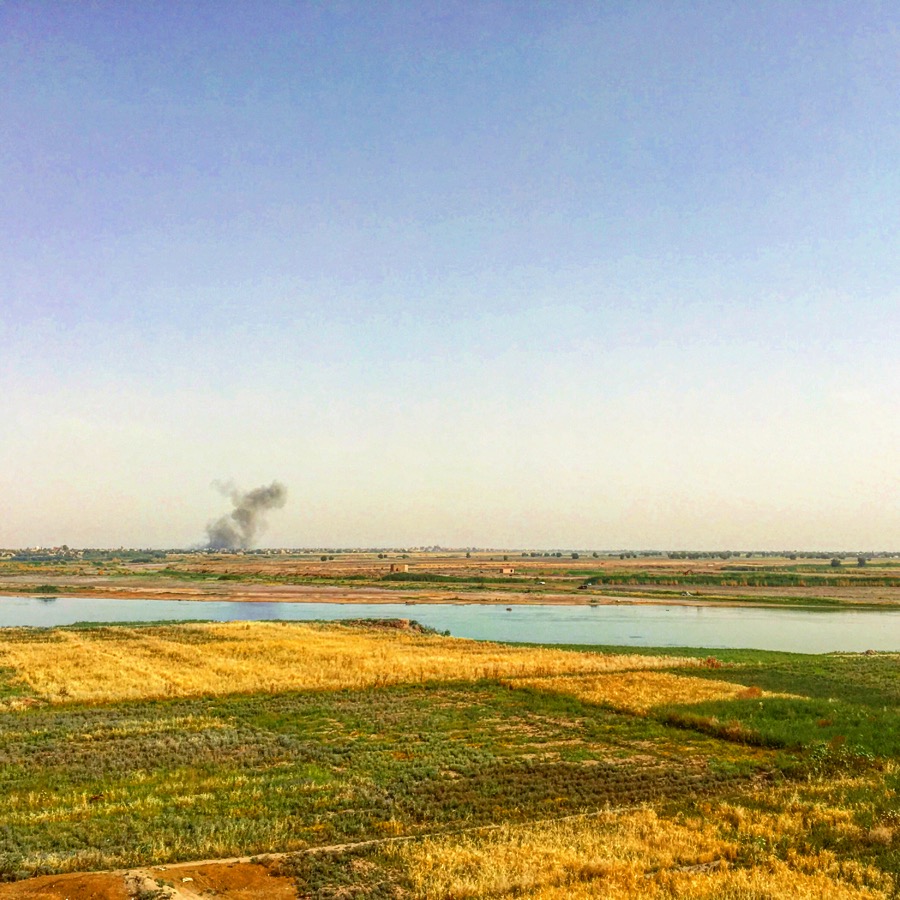DEIR Ez-ZOR, Syria — On a rooftop overlooking the Islamic State-held town of Hajin in far eastern Syria, fighters from the Deir Ezzor Military Council, a local sub-militia of the U.S.-backed Syrian Democratic Forces (SDF), watch dispassionately as heavy mortars sail overhead and land in clouds of grey dust in the townscape just ahead.
This conservative tribal region is the site of the Islamic State group’s last stand in eastern Syria, but the grueling battle these men expected has not materialized.
Videos by VICE
“They strike at night, and we strike back and kill them,” said Hamad Nahar Al-Hamad, the 21-year-old commander of the unit. “They used to have power in this area, but that isn’t the case anymore.”
Instead, fighters like Hamad now find themselves in the middle of a war for influence between Bashar Assad’s forces, backed by Russia and Iran, and the Kurdish-led SDF backed by the United States. Rich in oil, and sitting astride lucrative trade and smuggling routes to Iraq, Eastern Syria is a crucial piece of the greater Syrian chessboard, and both sides are looking to manipulate the region’s complex tribal political networks in a bid for regional supremacy.
What comes of this tug of war could decide the fate of nearly half the country.
Bad blood

Not far from here, U.S. jets recently killed hundreds of Russian contractors who attempted an assault on SDF-controlled oil fields. But today, the scene is almost bucolic, save for the Coalition jets circling overhead. Farmers harvest crops nearby as kingfishers dart across the river; a group of fighters swim in the narrow tributary of the Euphrates dividing SDF territory from that of the Syrian government.
Like most of his soldiers, Hamad came from the Shaitat tribe, a local Sunni Arab tribe that rose up en masse against ISIS intruders in 2014.
“When ISIS came, they wanted to teach the Shaitat Islam from scratch,” said Hamad, “The Shaitat did not accept that. So they fought ISIS back.”
The Shaitat ultimately paid a heavy price. Some 800 were killed in the aborted uprising against ISIS, according to local human rights groups. And in the aftermath, many fled to Assad-controlled areas, where they joined the government’s fight against the terror group. Others stayed, eventually joining the local militia now allied with the U.S. military.
“All people want is to get rid of ISIS, and live in peace.”
As a result, many of the tribe’s survivors could soon find themselves lining up on opposing sides, as the war here shifts from one focused on ISIS to a larger geo-strategic battle between Assad and his allies and the U.S. Locals openly acknowledge that Assad’s government is already trying to use tribal bonds and patronage networks to foment dissatisfaction with the American presence here.
“They are trying with the clan chiefs, yes, but the clan chiefs don’t trust the regime anymore,” said Ahmad Ashour, an Arab YPG fighter attached to the Deir Ezzor Military Council (DMC). “They displace people from their houses and send them over to our side. They gather their belongings and burn their houses down. People know the truth, especially the clan chiefs. They can’t trick them like before.”
SDF fighters are aware of this dynamic, but reject the suggestion that it will lead to intra-tribal conflict in the future.
“All people want is to get rid of ISIS, and live in peace,” said Hamad, “But if the regime comes here, the tribes will revolt against them. The tribes don’t like the regime.”
Assad’s interests here are obvious: the region may be poor and underdeveloped, but Deir Ezzor contains Syria’s two largest and most productive oil fields, al-Omar and Tanak, which are both under SDF control. The United States too has a stake, as the oil fields will make for a powerful bargaining chip with Damascus in any future peace settlement.

For now, Tanak functions as a rear field hospital for the DMC, and it keeps busy. Throughout the night, ambulances scream through the desert on their way to the hospital entrance here, disgorging the casualties of war.
In a dimly lit operating theatre, Kurdish doctors try and fail to resuscitate one young fighter, accidentally gunned down by his comrades. Eventually they pronounce him a martyr, bag him up and send him home for burial. Another fighter is brought in wounded from being shot in the head at close range by two assailants in civilian clothes on a motorbike.
“By the ISIS cells,” his commander explains, “they don’t do open confrontation any more.”
Local analysts are worried that ISIS is melting back into the civilian population, waiting to start an underground insurgency once the pressure has abated.
The ghosts of ISIS
About an hour’s drive away in a lonely fort constructed of sand, the militia’s spearhead unit dozes the afternoon heat away in a Bedouin tent. A few hundred feet across the horizon, an identical sand fort, nominally held by ISIS, blocks the way to the village of Baghoz. A barefoot fighter manning a machine gun keeps watch.

Soon, a small patrol of American and French Special Forces arrive. They examine the ISIS position with interest. The U.S.-armored vehicle fires a few rounds at it from the .50 calibre machine gun mounted on its turret, hoping to flush out anyone or thing responsible movement.
Nothing’s doing.
“I’ll get the Barrett?” a French commando asks, referring to the heavy-calibre sniper rifle stowed in the back of his pick-up truck.
“No, no, there’s no need,” replies a French-speaking American operator.
The soldier returns with the rifle anyway, lays down in the sand and fires seven or eight shots at the hut in quick succession.
Still nothing.
After a while, the SOF operators drive away again, leaving the DMC fighters alone. They brew tea, sit around declaiming traditional poetry to one another, and bemoan the desperate tactics of their enemies
“ISIS don’t fight anymore,” complains one grey-bearded fighter, “they just plant mines, the Jewish pigs.”
The fighters will be gripped by a brief moment of excitement a few hours later, when one of them spot some movement on the horizon. They fire off a few rounds from the heavy machine gun that’s mounted onto their American-supplied Humvee that still bears its shipping labels.
Their target, it soon becomes apparent, is a plastic bag fluttering off into the desert wind.

Allahu Akbar, they shout as the gun’s booming report echoes across the empty sand.
“Don’t say that, comrade,” shushes a YPG media officer accompanying us, a Kurd from Kobane. “Why not? You say Long Live Abdullah Ocalan and we say Allahu Akbar,” retorts one fighter.
Playing for the winning team
Like many in Deir Ezzor’s military council, this fighter has had a long and tangled military career since Syria’s civil war erupted in 2011. First he was a member of local rebel group Ansar al-Sunnah, then the Mu’atah brigade, then the jihadist group Ahrar al-Sham and the Syrian al-Qaeda faction Jabhat al-Nusra.
“I worked with Jabhat Al Nusra for a short while, less than a month,” he explains, “before joining the FSA. I didn’t like the organization there, al Qaida and whatnot, so I left and joined the FSA factions, and it was the same thing, they were failures. I participated with them, and it was chaos, there was no organization like the SDF. Here we have military organization, there, there was none.”

The combination of military efficiency that is the SDF’s trademark, and the generous supply of arms, vehicles, airstrikes and pay from its U.S. ally has transformed nearby militias like the DMC from ragtag groups of rebels into the dominant force here.
Fighters from all sides have joined the SDF and its local sub-militias, and continue to do so, attracted primarily by the desire to be on the winning team. But the group’s strength is largely conditional on sustained support of the U.S. military, which is far from a guarantee.
When ISIS finally collapses in the coming weeks, the U.S. will have technically completed its original mission. President Donald Trump, then, will face a choice: maintain a U.S. presence in Syria in support of the SDF or pull-out, touting “mission accomplished.” What he decides to do next is a mystery, but it will change the future of these tribal warriors, and this dusty, neglected region forever.
Cover image: Tribal fighters from the Deir Ezzor Military Council in their desert outpost. (Aris Roussinos for VICE News).




